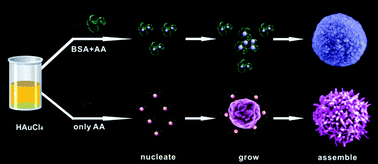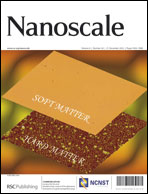The hierarchically assembled Au microspheres/sea urchin-like structures have been synthesized in aqueous solution at room temperature with and without proteins (bovine serum albumin, BSA) as mediators. The average diameter of an individual Au microsphere is 300–600 nm, which is composed of some compact nanoparticles with an average diameter of about 15 nm. Meanwhile, the sea urchin-like Au architecture exhibits an average diameter of 600–800 nm, which is made up of some nanopricks with an average length of 100–200 nm. These products are characterized by means of scanning electron microscopy (SEM), X-ray diffraction (XRD) and transmission electronic microscopy (TEM). It is found that the BSA and ascorbic acid (AA) have great effects on the morphology of the resulting products. Two different growth mechanisms are proposed. The study on surface enhanced Raman scattering (SERS) activities is also carried out between Au microspheres and Au sea urchin-like architectures. It is found that Au urchin-like architectures possess much higher SERS activity than the Au microspheres. Our work may shed light on the design and synthesis of hierarchically self-assembled 3D micro/nano-architectures for SERS, catalysis and biosensors.

You have access to this article
 Please wait while we load your content...
Something went wrong. Try again?
Please wait while we load your content...
Something went wrong. Try again?


 Please wait while we load your content...
Please wait while we load your content...